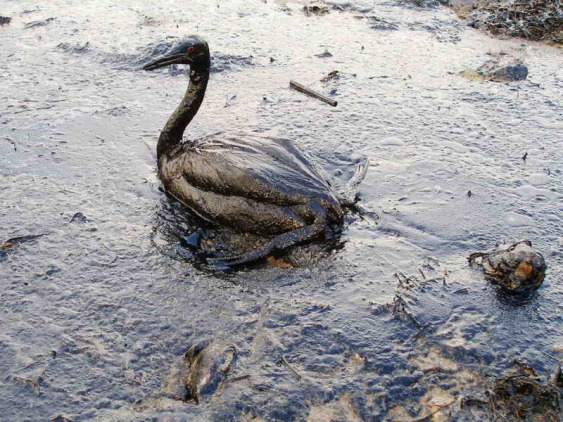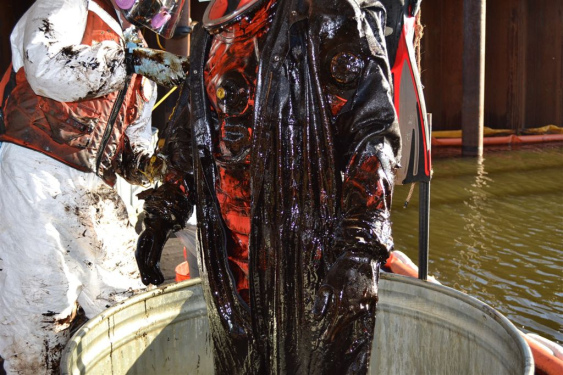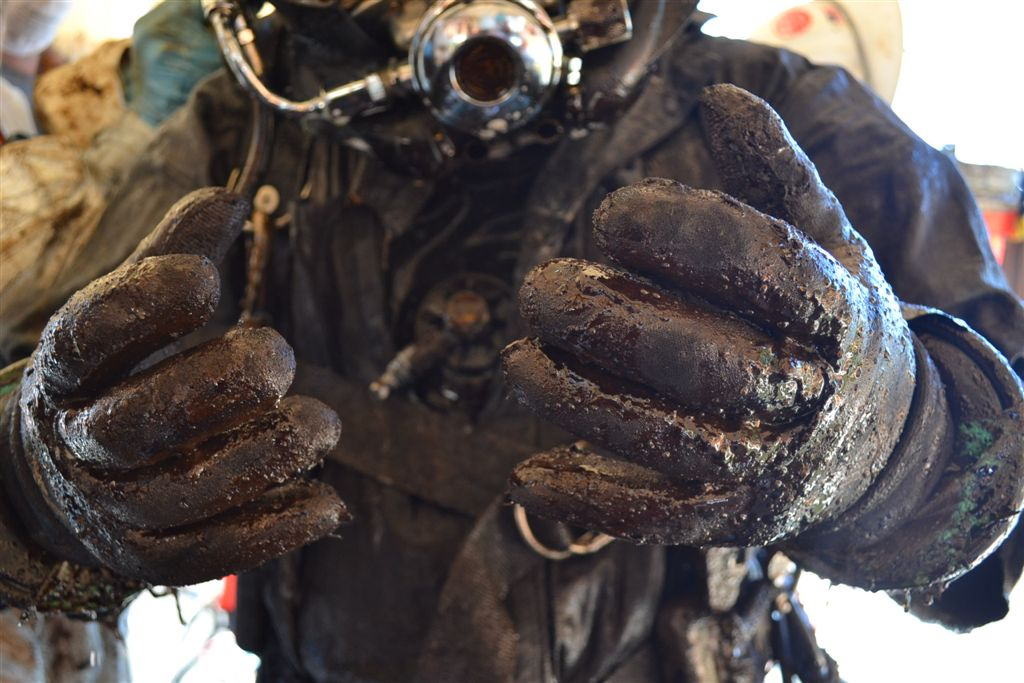Washington’s coastlines and waterways are at a threshold. Battered by a legion of insults—polluted runoff, shoreline development, carbon-induced acidification, and more—there is no guarantee that the Northwest can continue to support the vibrant natural systems it is known for. The region’s native orcas are struggling; key populations of shellfish and herring may be dying out; and even its flagship species, the salmon, are endangered in many places. And what is perhaps the biggest threat of all looms like a specter: a catastrophic oil spill.
Every day the region faces the risk of an oil spill. Though Washington officials have been more diligent in their preparations than their counterparts elsewhere, there is good reason to believe we are not prepared. In fact, a review of the record shows that our business-as-usual approach has let us down at many times and in many places.
Certainly, we are not up to the task of protecting Northwest waters from the titanic increases in oil transport planned by pipeline companies, refineries, and would-be exporters. To understand why, it helps to recall our history lessons. The fact is that Washington has already suffered numerous damaging spills.
Here are a few of the worst.
Pacific Coast (March 1964)
A tugboat towing a barge loaded with gasoline from the Ferndale refineries was making a delivery run down the outer coast to Coos Bay, Oregon when the tow line ran off its winch drum during a storm in the middle of the night. Set adrift, the 200-foot barge, which was carrying 2,352,000 gallons of gasoline, diesel, and stove oil, soon grounded on a sandbar several hundred yards offshore between Moclips and Pacific Beach, just south of the Quinault Indian Reservation.
Rough surf pounded the stranded barge and stymied the Coast Guard’s initial efforts to pull it free. It took more than five days, and the assistance of another tug dispatched from Grays Harbor, before workers were finally able to move the barge off the bar, but while they struggled 1.2 million gallons of petroleum leaked into the water. The spill fouled beaches from the Quinault Reservation south for 10 miles, killing untold numbers of seabirds. Wildlife researchers also reported massive shellfish deaths: 32,000 pounds of razor clams were killed by the spill, and officials immediately closed clam digging everywhere north of the Copalis River.
In an out-of-court settlement, the United Transportation Company eventually agreed to pay $8,000 in damages—about $61,000 in today’s dollars.
Shi Shi Beach (January 1972)
In another episode of a tug losing its tow in a winter storm, a snapped towline allowed a troop transport vessel to drift into rocks just offshore the southwest corner of the Makah Indian Reservation. The USS General M.C. Meigs— which had seen time in World War II and the Korean War—broke up against the rocks, spilling an estimated 2.3 million gallons of heavy fuel oil into the water over the course of the following 10 months. Researchers documented a dramatic die-off in purple sea urchin populations near the spill site, and petroleum residue continued to show up in crabs and other marine animals for as long as a year after the initial spill.
The wreck was never cleared and can still be seen in satellite pictures.
Columbia River, near Ridgefield (March 1984)
The tanker ship Mobiloil was just ten miles downstream from its destination of Portland when it began experiencing rudder failure. Unable to regain steering, the tanker ran aground near Warrior Rock, ripping a long gash through its starboard cargo tanks. A week later, rescuers were finally able to refloat the vessel and escort it to a dry dock in Portland, but not before it leaked as much as 233,000 gallons of heavy fuel oil into the Columbia River.
Some of the oil sank into the river bed, while the rest was pushed downstream by the flow. In the ensuing weeks, beaches as far away as Cannon Beach, Oregon, and Cape Flattery, Washington, were coated in oil, with the highest concentrations along the river’s beaches and the swath of shoreline from Cape Disappointment north to Grays Harbor on the Washington Coast. Cleanup efforts were complicated by fluctuations in the river’s height that stranded oil on banks and re-oiled some areas multiple times. On top of that, swift current conditions pushed spilled oil under the booms that were designed to contain it, rendering attempts at open water recovery largely ineffective.
The spill killed thousands of seabirds along the river and coast. Chemical samplings of sturgeon in the river found high concentrations of petrochemicals. The rich shellfish beds of Willapa Bay and Grays Harbor were coated in oil.

Port Angeles Harbor (December 1985)
Like many tanker ships bringing Alaskan North Slope crude oil from Valdez to Washington, the Arco Anchorage anchored in Port Angeles Harbor while it waited its turn to offload at the Cherry Point refinery pier. Despite calm seas and near perfect visibility, however, the tanker ran aground in the harbor, tearing two long holes in the hull. Oil began leaking immediately, and continued for four hours until the ship’s crew was finally able to transfer oil from the damaged compartment to another tank on the ship. By that time, about 239,000 gallons of Alaskan crude had spilled into the harbor.
In spite of 4,500 feet of containment booming placed around the vessel, the wind and tides carried the oil as far east as Dungeness Spit and nearly as far west as Neah Bay. During an intensive, four-month cleanup operation, 2,400 volunteers (many of them working shifts longer than 12 hours) helped to recover about half of the spilled oil and clean oil from the fur and feathers of local wildlife. According to one volunteer, “Some were hard to distinguish what species they were, they were so saturated with oil.” The oil spill killed over 4,000 seabirds, along with an untold numbers of harbor seals, otters, shellfish, and salmon. The 15 million board feet of oiled logs presented an interesting challenge; eventually officials determined that the logs could be cleaned reasonably well by dragging them through a car wash and by spraying them with high-pressure fire hoses.
The Washington State Department of Ecology fined Arco and the vessel pilot $30,000 each.
Fidalgo head (January 1988)
While being towed from the Texaco refinery in Anacortes to Seattle, the tank barge MCN-5 capsized and sank in Rosario Strait with more than 327,000 gallons of heavy cycle gas oil on board. Salvage crews managed to pump much of the trapped oil out of the barge, but 67,000 gallons spilled into the Sound. Most of that oil sank, endangering shellfish, crabs, and other species.
The salvage effort alone cost the federal government more than $1.1 million, but the barge owner’s liability was limited to $150,000.
Ocean Shores (December 1988)
En route from BP’s Cherry Point refinery to Portland, with a delivery stop at Aberdeen along the way, the tugboat Ocean Service towing the barge Nestucca attempted to cross the bar into Grays Harbor just before midnight. A winter storm was moving in, and the barge was experiencing breaking waves as tall as 16 feet. As the tug crew tried to shorten the length of its towline, the line snapped and the barge—loaded with 70,000 barrels of bunker fuel—began to drift rapidly toward the harbor jetty. Then, as the tug operators attempted to reestablish the tow line before the barge ran aground, the tug collided with the bow of the barge, ripping a large gash in its hull. The crew eventually reattached the line to the barge and averted the grounding, but heavy fuel oil continued to leak from the damaged barge for 23 hours until the weather calmed enough for them to patch the hole. In the intervening time, some 231,000 gallons spilled into the sea, fouling beaches from Oregon to Vancouver Island.
The bulk of the oil washed up around Ocean Shores. The oil killed or injured 56,000 seabirds, and cleanup workers sent 585 tons of oiled waste to landfills and had to burn 45,000 cubic yards of oiled driftwood. The spill helped spur the launch of the Pacific States-British Columbia Oil Spill Task Force.
Cape Flattery (July 1991)
A Japanese-fish processing vessel Tenyo Maru and a Chinese freighter Tuo Hai collided about 25 miles northwest of Cape Flattery. The Tenyo Maru sank within minutes. One crew member drowned, and its fuel tanks, carrying 475,000 gallons of fuel oil, began leaking.
Oil washed ashore for several days after the sinking at points along the Washington coast, including Shi Shi beach, Cape Flattery, and the area between Tatoosh Island and Rialto Beach. Shorelines in the Makah Reservation and Olympic National Park were the hardest hit. The wreck continued to leak a large volume of oil, approximately 361,000 gallons in total, for more than a month before a remote control submersible’s operators managed to safely pump the remaining fuel out of the vessel. In the meantime, the oil killed or injured at least 4,300 seabirds, including federally threatened marbled murrelets, along with an unknown number of sea otters and harbor seals. The spill also did substantial damage to kelp beds where toxic concentrations of oil lingered for more than two weeks. Worsening the situation was the fact that several other vessels used the Tenyo Maru spill as an opportunity to dump waste oil illegally into the already oiled waters. In total, cleanup crews collected about 35,000 garbage bags of oily debris.
In 1994, the Maruha Corporation, the owner and operator of the Tenyo Maru, agreed to pay $9 million in penalties and cleanup fees.

Padilla Bay (December 1994)
The Crowley Marine Services’ Barge 101 leaked an estimated 26, 936 gallons of diesel oil into Rosario Strait and the waters north of Anacortes before the tug boat crew towing the barge noticed the spill. It took several more hours before they managed to halt the flow of oil leaking from a four foot gash in one of the barge’s cargo tanks. The Office of Marine Safety determined that the barge ruptured after running aground somewhere on Clements Reef, north of Sucia Island.
Oil affected beaches on Guemes Island (where herring were spawning at the time), as well as on Blakely, Cypress, Sinclair, and Orcas Islands and yet the Coast Guard elected to forgo an intensive cleanup effort. A skimmer collected around 200 gallons of oil from around the barge, and several oiled birds were taken to a wildlife rehabilitation center.
The Department of Ecology purchased 450 acres of tidelands in Fidalgo Bay for $327,602 with the damage settlement from the Barge 101 spill.
Tacoma (January 1998)
Crews aboard the cargo vessel Anadyr accidentally overfilled the ship’s fuel tanks, spilling around 7,500 gallons of fuel oil into the Sitcum Waterway. The slick affected dozens of birds, and crews worked for almost a week just to clean the Anadyr so it could be moved and allow cleanup operations under nearby docks to begin.
The Department of Ecology fined the vessel owners $182,000 for the spill, and the State Attorney General added a $93,872 claim for environmental damages.
Point Wells (December 2003)
Crews loading a tank barge with heavy fuel oil at the Point Wells ChevronTexaco terminal near Shoreline miscalculated the flow rate and overfilled the barge’s cargo tanks. The error spilled approximately 4,700 gallons into Puget Sound, most of which washed ashore between Point Jefferson and Indianola on the Kitsap Peninsula where it coated a mile and a half of beach and fouled the critical forage fish habitat in Doe-Kag-Wats saltwater marsh on the northern shore of Port Madison. The oil killed many seabirds and at least one harbor seal pup and disrupted shellfish harvesting for months.
The Washington Department of Ecology found Foss Maritime, the owner and operator of the tank barge, negligent in causing the spill and compelled the company to pay for the full $4.5 million cost of the 115-day cleanup effort plus $577,000 in state penalties.
Dalco Passage (October 2004)
At 1:30 in the morning, a tug boat operator sailing through the Dalco Passage between Vashon Island and Point Defiance called the National Response Center to report coming across an oil spill. Darkness and heavy fog hindered the initial response, and patches of oily sheen drifted as far south as the Tacoma Narrows and as far north as Eagle Harbor on Bainbridge Island. Officials closed parks on Vashon and Maury islands and suspended shellfish and seaweed harvesting as cleanup crews worked to recover an estimated 59 tons of oily debris from the shorelines and 6,842 gallons of oily water with skimming operations. The Coast Guard eventually tracked the spilled oil back to the Polar Texas, a tanker vessel owned by oil giant ConocoPhilips. The vessel had been involved in another spill four years earlier when it was owned by Arco.
ConocoPhilips repeatedly denied that the Polar Texas was responsible for the spill, though the firm ultimately agreed to pay $588,000 to settle damage claims from federal and Washington state environmental agencies, which spent around $2.23 million responding to the spill.
Columbia River, near Camas (January 2011)
The Washington Department of Ecology traced an oil sheen spotted on the Columbia River near Vancouver 11 miles upstream to the 431-foot flat-deck barge Davy Crockett. Partially sunk just off the north riverbank, the derelict barge had begun leaking fuel oil during an unpermitted scrap metal salvage operation. Cleanup efforts eventually recovered 1.6 million gallons of oily water and an additional 38,000 gallons of bunker oil. The Coast Guard also removed 4,850 pounds of asbestos from the vessel in a $23 million operation to safely dismantle and extract the entire barge from the river.
The Department of Ecology fined the owner of the vessel $405,000, and the US District Court in Seattle sentenced him to four months in prison.
What the future holds
In the next year or so, officials in Washington will decide whether to permit huge new oil facilities that will bring an unprecedented growth of crude by both land and sea, while Canadian regulators weigh a massive tar sands pipeline pointed at the Salish Sea. These plans would greatly increase oil-bearing vessel traffic in important waterways.
Yet the impacts of these developments are not well understood. They are almost certain to boost the risk of oil spills, perhaps dramatically so, in some of the Northwest’s most sensitive and economically important waterways.
In the coming weeks, Sightline will explore these features in detail in our series, The Risk of Northwest Oil Spills.


Comments are closed.